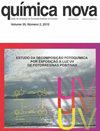加工食品中的农药——天然葡萄汁中多重残留农药的高分辨质谱分析
IF 0.5
4区 化学
Q4 CHEMISTRY, MULTIDISCIPLINARY
引用次数: 0
摘要
葡萄是世界上种植最广泛的水果之一,巴西的大部分生产集中在天然葡萄汁上。本研究对2种天然葡萄汁的40份样品,采用基于改进QuEChERS的多残留提取技术,采用液相色谱-高分辨率质谱(LC-HRMS)分析了86种农药残留。检测限和定量限分别小于6 μg L-1和20 μg L-1, RSD < 20%, R2 < 0.99,回收率为80% ~ 120%。该方法具有良好的线性度、真实度、重复性和日间精密度等性能特点。结果,在实际样品中检出7种农药(嘧菌酯、苯那甲酯、多菌灵、替布康唑、甲基硫代菌酯、吡丙西芬、嘧霉胺)。采用该方法对市场上40份天然白葡萄汁和红葡萄汁样品进行了86种多类农药残留量的同时评价。定量限(loq)较低,对样品进行了测试,结果表明该方法具有一定的适用性,可用于常规分析。因此,这项工作也可以作为对加工产品污染的警告。本文章由计算机程序翻译,如有差异,请以英文原文为准。
PESTICIDES IN PROCESSED FOOD - MULTIRESIDUE PESTICIDES IN NATURAL GRAPE JUICES BY HIGHRESOLUTION MASS SPECTROMETRY
Grapes are among the most widely cultivated fruits in the world, with the majority of Brazilian production focusing on natural grape juice. In this work, a total of 40 samples of 2 types of natural grape juice were analyzed for the presence of 86 pesticide residues, with multiresidue extraction based on modified QuEChERS, by liquid chromatography with high-resolution mass spectrometry (LC-HRMS). Limits of detection and quantification were below 6 μg L-1 and 20 μg L-1, RSD < 20%, R2 > 0.99 and recovery ranged from 80 and 120%. Thus, the developed method was validated and good performance characteristics such as linearity, trueness, repeatability and inter-day precision were obtained. As results, 7 pesticides were detected in real samples (azoxystrobin, benalaxyl, carbendazim, tebuconazol, thiophanate-methyl, pyriproxiphen and pyrimethanil). The method was successfully validated for simultaneous evaluation of 86 multiclass pesticides residues levels, which was applied in 40 natural white and red grape juice market samples. The limits of quantification (LOQs) were low enough and the method was tested on samples showing its applicability, and therefore, this method can be used in routine analysis. Also, this work therefore also serves as an alert regarding the contamination of processed products.
求助全文
通过发布文献求助,成功后即可免费获取论文全文。
去求助
来源期刊

Quimica Nova
化学-化学综合
CiteScore
1.60
自引率
12.50%
发文量
72
审稿时长
2-4 weeks
期刊介绍:
Química Nova publishes in portuguese, spanish and english, original research articles, revisions, technical notes and articles about education in chemistry. All the manuscripts submitted to QN are evaluated by, at least, two reviewers (from Brazil and abroad) of recognized expertise in the field of chemistry involved in the manuscript. The Editorial Council can be eventually asked to review manuscripts. Editors are responsible for the final edition of QN.
 求助内容:
求助内容: 应助结果提醒方式:
应助结果提醒方式:


